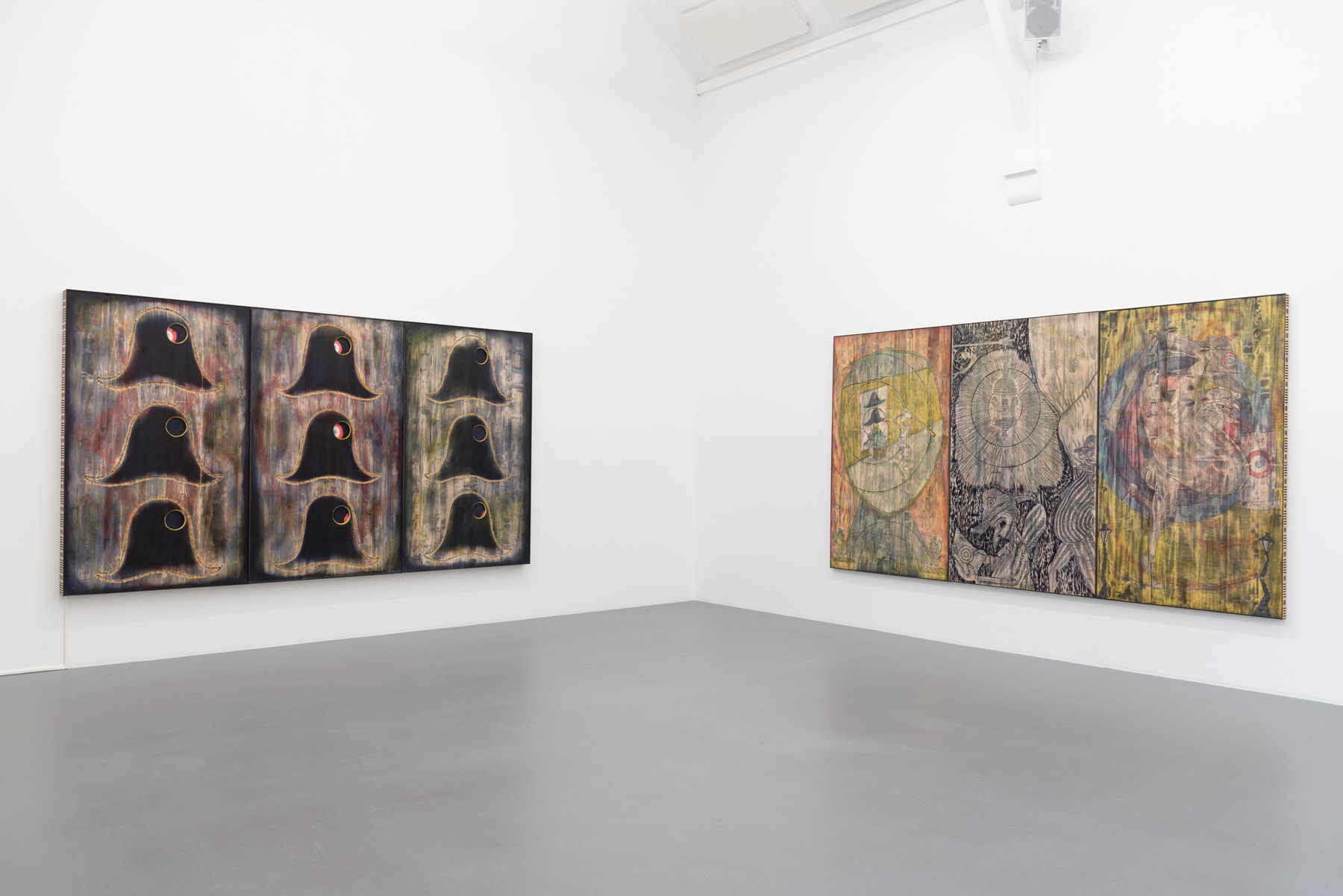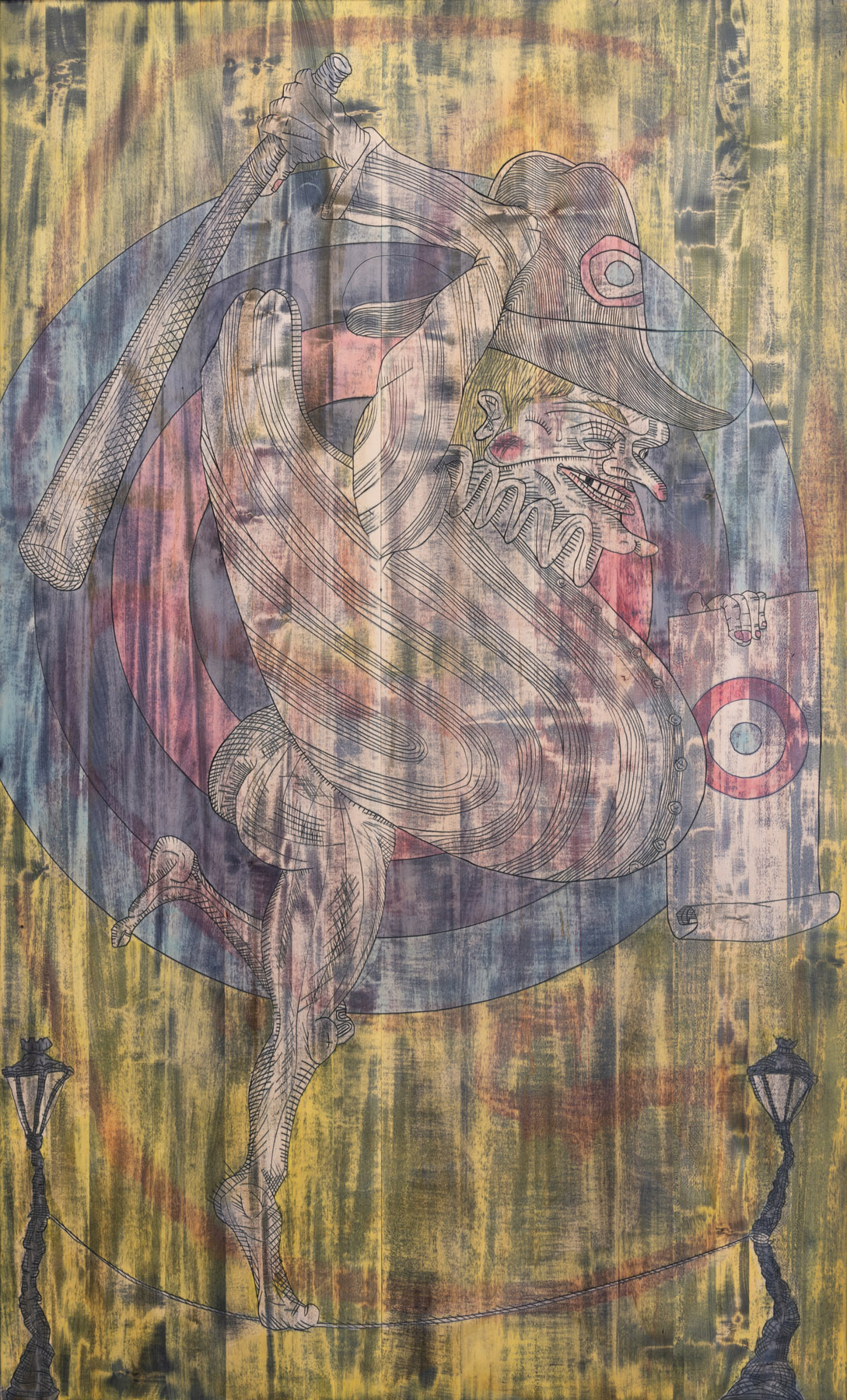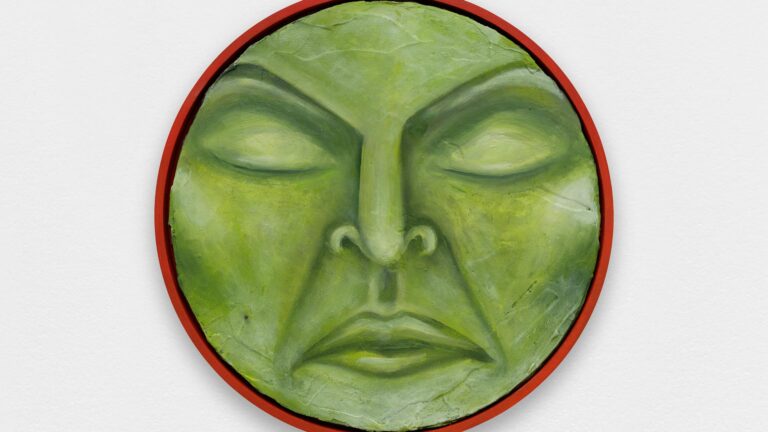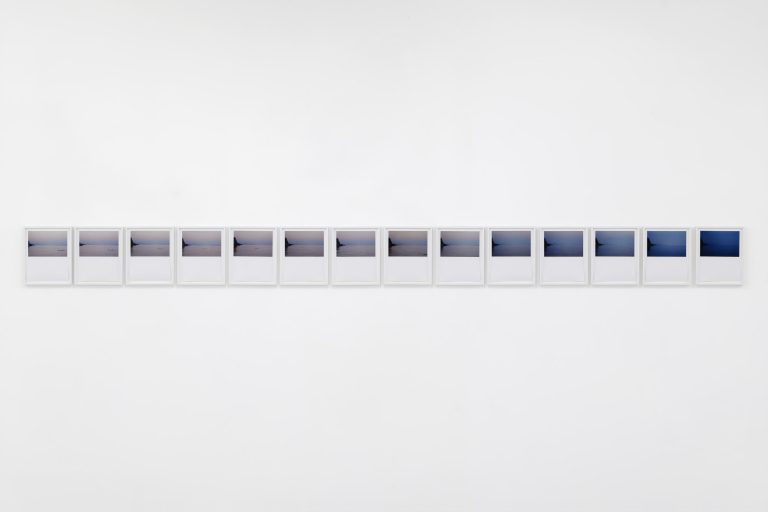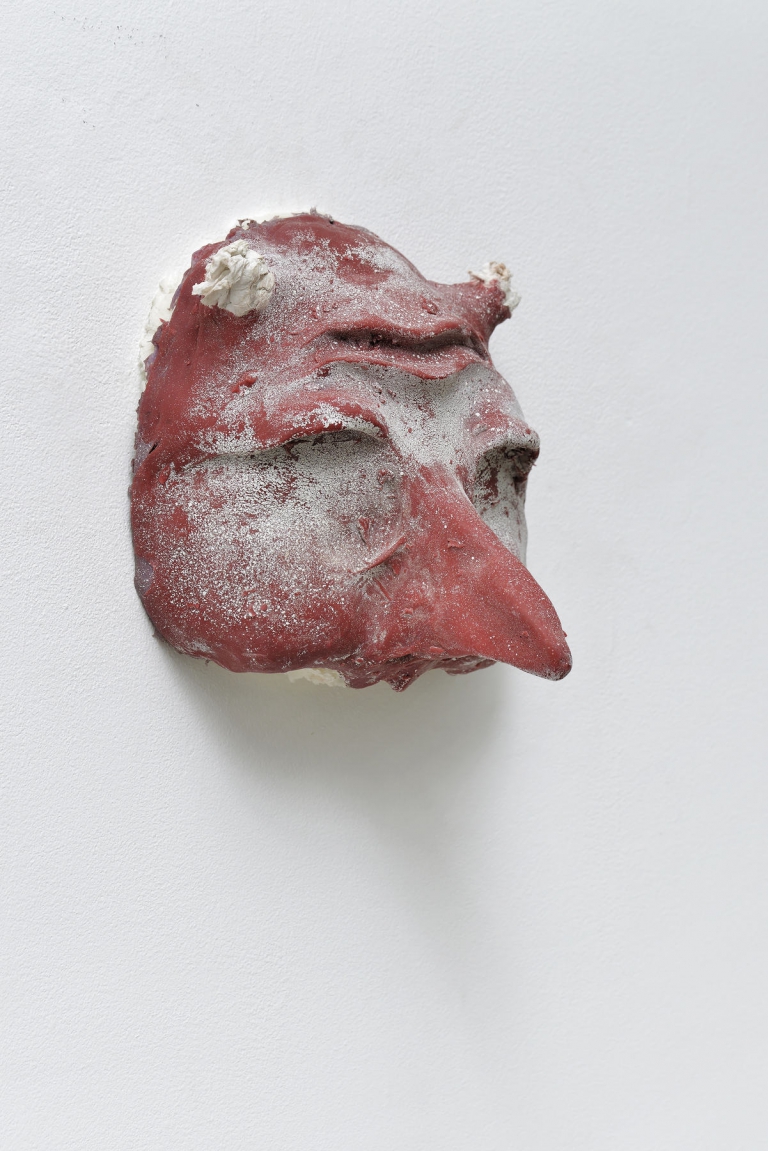Artists: Mathis Collins & Paul Collins
Exhibition title: Mime
Curated by: Émilie Renard
Venue: La Criée centre d’art contemporain, Rennes, France
Date: September 26 – December 30, 2020
Photography: all images copyright and courtesy of the artists, Crèvecœur, Paris, General Hardware Contemporary, Toronto and La Criée centre d’art contemporain, Rennes
Mathis Collins carves wood into figures laughing or crying, mocking and mute. He begins by roughing out different planes in the thickness of boards, then gouges their surface so that the force, angle and attack of each stroke definitively mark their volumes and textures.
The black outlines and colours he uses to embellish these bas-reliefs are likewise obtained by elimination: after painting his chosen surfaces, he sands them back, leaving only the coloured residue in the grain of the wood. In addition to being unpredictable – a knot suddenly pops out, leaving a hole – this method is slow to bring forth its smeared faces, wan street-lighting and pale sunrises. Self-taught, Collins is now a master of his craft, but he shares with practitioners of art brut a mortal horror of a vacuum. Here he has complemented his carved compositions with moving parts whose rudimentary mechanisms reveal a parade of tricolour cockades that pass for targets.
All this toil to produce these primitive shapes leaves Collins’s errant characters the time to clamber up from the limbo of their micro-histories to the surface of a limewood plank. Sometimes undertaken bit by bit and involving the mouths, feet, noses and hats of people with sometimes no more than the costumes on their backs, this is quite a journey. The launchpad, in Paris around 1680, was something between the premises of the Comédie Française and the trestles of street theatre. So much for the overall picture: the theatre that took shape in the city’s fairs was the core factor in the rivalry between the Comédie Française and the Commedia dell’arte. Jealous of the popularity of the streetwise competition, the tiny élite of “the King’s troupe” persuaded Louis XIV to grant them exclusive rights to on-stage dialogue in French – with armed enforcement from the police. The dissident troupes, however, very quickly found canny modes of resistance: placards were displayed and marionettes and ropewalkers spoke; mimes mimed; actors and actresses delivered monologues, replying from among the crowd or letting the crowd itself reply; speech bubbles were brought out; there was gibberish in Latin. Result: all sorts of gambits for subverting the academic constraints of classical theatre.
For Collins the emergence of these Parisian proto-countercultures driven by working-class dissent has become an image source and the underpinning of a transhistorical narrative he has been monitoring with regard to himself and his time. This is the history of the control of voices, bodies and behaviour, impelled by a network of skilled mimes who have rendered it more discreet, more nuanced and more democratic. Given today’s omnipresent abuses of power, Collins resorts to all the costumes. His work is peopled by comical, solitary alter egos – artist-clown, artist-educator, artist-cop – sprung from the popular
archetypes of the Commedia dell’arte, carnivals, bistros, life after dark, and art and culture education programmes for sensitive urban areas. He is the mime who knowingly exaggerates, who works both sides of the fence, gifted with an ambiguous silence. He is the watchful cop who sometimes lashes out, the bureaucrat who gives orders, the mediator who reconciles, the clown trying to act the buffoon, the willing public or the guy with his own idea of art. He is also his artist father, invited here to help him invent a different kind of interactive aesthetic. Through them, he mimes.
A conversation about the artistic value of artistic education is taking place here between two artists, a son and a father. Each of them is also a teacher: the former in creative workshops, the latter in an art school. At issue are work processes and their reciprocal influences.
In his new series, History of Modern Art, Paul Collins looks back to his art studies in Toronto in the 1970s, reproducing pages from the books that impacted his training either academically or aesthetically: the school textbook History of Modern Art by H.H Arnason, the art magazine Parachute, a catalogue of the painter Robert Motherwell, a typographical composition guide, a grid setting out the standard canvas formats according to the pictorial genres “portrait, landscape, marine”, and a page of concrete poetry. Already famous by that time was The Medium Is the Massage (1967), by Marshall McLuhan and graphic designer Quentin Fiore, a book whose title wittily exploited a typographical error in the media’s handling of a phrase that had become a slogan: The medium is the message. McLuhan’s theory was that the medium was the true vehicle of information, and described a form of collusion between the channel (the medium) and its content (the message). While McLuhan was paving the way for “media studies” in Canada, Paul Collins was making the transition from experimental “free schools” to university lecture theatres. The hallucinatory effects of a massage with a message can be applied to Collins’s paintings because they are based on printed documents which, in the course of their successive modulations, have both lost some of their content and gained a certain sensuality.
Replicated by means of overlaid, slightly out of register grids, text and illustrations dissolve into shimmering, more or less dense coloured areas. In the course of its transfers from one medium to another – from printed page to photocopy to canvas – the message seems to have evaporated on contact with the canvas, giving way to free-floating images. These pictorial processes show Collins returning to the printing profession he learned hands-on at the same period, working in independent publishing houses.
Here, in his History of Modern Art, he recounts a personal journey in the context of a collective visual culture: in other words a late 20th-century, vernacular vision of art in a North American vein.
— Émilie Renard
Paul Collins and Mathis Collins, Mime, exibition view, La Criée centre for contemporary, Rennes, 2020, courtesy of the artists, General Hardware Contemporary, Toronto and Crèvecœur, Paris – production: La Criée centre d’art contemporain, Rennes – photo: Benoît Mauras
Paul Collins and Mathis Collins, Mime, exibition view, La Criée centre for contemporary, Rennes, 2020, courtesy of the artists, General Hardware Contemporary, Toronto and Crèvecœur, Paris – production: La Criée centre d’art contemporain, Rennes – photo: Benoît Mauras
Paul Collins and Mathis Collins, Mime, exibition view, La Criée centre for contemporary, Rennes, 2020, courtesy of the artists, General Hardware Contemporary, Toronto and Crèvecœur, Paris – production: La Criée centre d’art contemporain, Rennes – photo: Benoît Mauras
Paul Collins and Mathis Collins, Mime, exibition view, La Criée centre for contemporary, Rennes, 2020, courtesy of the artists, General Hardware Contemporary, Toronto and Crèvecœur, Paris – production: La Criée centre d’art contemporain, Rennes – photo: Benoît Mauras
Paul Collins and Mathis Collins, Mime, exibition view, La Criée centre for contemporary, Rennes, 2020, courtesy of the artists, General Hardware Contemporary, Toronto and Crèvecœur, Paris – production: La Criée centre d’art contemporain, Rennes – photo: Benoît Mauras
Paul Collins and Mathis Collins, Mime, exibition view, La Criée centre for contemporary, Rennes, 2020, courtesy of the artists, General Hardware Contemporary, Toronto and Crèvecœur, Paris – production: La Criée centre d’art contemporain, Rennes – photo: Benoît Mauras
Paul Collins and Mathis Collins, Mime, exibition view, La Criée centre for contemporary, Rennes, 2020, courtesy of the artists, General Hardware Contemporary, Toronto and Crèvecœur, Paris – production: La Criée centre d’art contemporain, Rennes – photo: Benoît Mauras
Paul Collins and Mathis Collins, Mime, exibition view, La Criée centre for contemporary, Rennes, 2020, courtesy of the artists, General Hardware Contemporary, Toronto and Crèvecœur, Paris – production: La Criée centre d’art contemporain, Rennes – photo: Benoît Mauras
Paul Collins and Mathis Collins, Mime, exibition view, La Criée centre for contemporary, Rennes, 2020, courtesy of the artists, General Hardware Contemporary, Toronto and Crèvecœur, Paris – production: La Criée centre d’art contemporain, Rennes – photo: Benoît Mauras
Paul Collins and Mathis Collins, Mime, exibition view, La Criée centre for contemporary, Rennes, 2020, courtesy of the artists, General Hardware Contemporary, Toronto and Crèvecœur, Paris – production: La Criée centre d’art contemporain, Rennes – photo: Benoît Mauras
Mathis Collins, Artiste policier à la fête à neuneu, 2020, Artiste policier en procès, 2020, Artiste policier mime, 2020, lime tree and wood stain, 200 × 120 × 3 cm, each, courtesy of the artist and Crèvecœur, Paris – production: La Criée centre for contemporary, Rennes – photo: Benoît Mauras
Mathis Collins, Artiste policier à la fête à neuneu, 2020, Artiste policier en procès, 2020, Artiste policier mime, 2020, lime tree and wood stain, 200 × 120 × 3 cm, each, courtesy of the artist and Crèvecœur, Paris – production: La Criée centre for contemporary, Rennes – photo: Benoît Mauras
Mathis Collins, Artiste policier à la fête à neuneu, 2020, Artiste policier en procès, 2020, Artiste policier mime, 2020, lime tree and wood stain, 200 × 120 × 3 cm, each, courtesy of the artist and Crèvecœur, Paris – production: La Criée centre for contemporary, Rennes – photo: Benoît Mauras
Mathis Collins, Artiste policier à la fête à neuneu, 2020, Artiste policier en procès, 2020, Artiste policier mime, 2020, lime tree and wood stain, 200 × 120 × 3 cm, each, courtesy of the artist and Crèvecœur, Paris – production: La Criée centre for contemporary, Rennes – photo: Benoît Mauras
Mathis Collins, Bicornes (stand de tir), 2020, lime tree, wood stain and motor, 200 × 360 × 3 cm, courtesy of the artist and Crèvecœur, Paris – production: La Criée centre for contemporary, Rennes – photo: Benoît Mauras
Mathis Collins, Artiste policier surpris par la mort, Artiste policier contre l’art, l’artisanat, Artiste policier danseur de corde, 2020, Lime wood, tint, 200 × 360 × 6 cm, courtesy of the artist and Crèvecœur, Paris – production: La Criée centre for contemporary, Rennes – photo: Benoît Mauras
Mathis Collins, Artiste policier surpris par la mort, Artiste policier contre l’art, l’artisanat, Artiste policier danseur de corde, 2020, Lime wood, tint, 200 × 360 × 6 cm, courtesy of the artist and Crèvecœur, Paris – production: La Criée centre for contemporary, Rennes – photo: Benoît Mauras
Mathis Collins, Artiste policier surpris par la mort, Artiste policier contre l’art, l’artisanat, Artiste policier danseur de corde, 2020, Lime wood, tint, 200 × 360 × 6 cm, courtesy of the artist and Crèvecœur, Paris – production: La Criée centre for contemporary, Rennes – photo: Benoît Mauras
Mathis Collins, Artiste policier surpris par la mort, Artiste policier contre l’art, l’artisanat, Artiste policier danseur de corde, 2020, Lime wood, tint, 200 × 360 × 6 cm, courtesy of the artist and Crèvecœur, Paris – production: La Criée centre for contemporary, Rennes – photo: Benoît Mauras
Mathis Collins, Artiste policier quittant Paris, 2020, Artiste policier et le Guignol’s Band, 2020, Artiste policier contre Poulbot, 2020, lime tree and wood stain, 200 × 120 × 3 cm, each, courtesy de l’artiste et de la galerie Crèvecoeur, Paris – production : La Criée centre d’art contemporain, Rennes – photo : Benoît Mauras
Mathis Collins, Artiste policier quittant Paris, 2020, Artiste policier et le Guignol’s Band, 2020, Artiste policier contre Poulbot, 2020, lime tree and wood stain, 200 × 120 × 3 cm, each, courtesy de l’artiste et de la galerie Crèvecoeur, Paris – production : La Criée centre d’art contemporain, Rennes – photo : Benoît Mauras
Mathis Collins, Artiste policier quittant Paris, 2020, Artiste policier et le Guignol’s Band, 2020, Artiste policier contre Poulbot, 2020, lime tree and wood stain, 200 × 120 × 3 cm, each, courtesy de l’artiste et de la galerie Crèvecoeur, Paris – production : La Criée centre d’art contemporain, Rennes – photo : Benoît Mauras
Mathis Collins, Artiste policier quittant Paris, 2020, Artiste policier et le Guignol’s Band, 2020, Artiste policier contre Poulbot, 2020, lime tree and wood stain, 200 × 120 × 3 cm, each, courtesy de l’artiste et de la galerie Crèvecoeur, Paris – production : La Criée centre d’art contemporain, Rennes – photo : Benoît Mauras
Mathis Collins, Artiste policier cible de toutes les critiques, 2020, Artiste policier hué, 2020, Artiste policier mort de rire, 2020, lime tree and wood stain, 200 × 120 × 3 cm, each, courtesy of the artist and Crèvecœur, Paris – production: La Criée centre for contemporary, Rennes – photo: Benoît Mauras
Mathis Collins, Artiste policier cible de toutes les critiques, 2020, Artiste policier hué, 2020, Artiste policier mort de rire, 2020, lime tree and wood stain, 200 × 120 × 3 cm, each, courtesy of the artist and Crèvecœur, Paris – production: La Criée centre for contemporary, Rennes – photo: Benoît Mauras
Mathis Collins, Artiste policier cible de toutes les critiques, 2020, Artiste policier hué, 2020, Artiste policier mort de rire, 2020, lime tree and wood stain, 200 × 120 × 3 cm, each, courtesy of the artist and Crèvecœur, Paris – production: La Criée centre for contemporary, Rennes – photo: Benoît Mauras
Mathis Collins, Artiste policier cible de toutes les critiques, 2020, Artiste policier hué, 2020, Artiste policier mort de rire, 2020, lime tree and wood stain, 200 × 120 × 3 cm, each, courtesy of the artist and Crèvecœur, Paris – production: La Criée centre for contemporary, Rennes – photo: Benoît Mauras
Paul Collins and Mathis Collins, History of Modern Art (for D. R.), 2020, acrylic on linen, lime blossom and wood stain, 146 × 97 cm, courtesy of the artists, General Hardware Contemporary, Toronto and Crèvecœur, Paris – production: La Criée centre d’art contemporain, Rennes – photo: Benoît Mauras
Paul Collins, History of Modern Art – p. 617, 2020, acrylic on linen, 100 × 81 cm, courtesy of the artist and General Hardware Contemporary, Toronto – photo: Benoît Mauras
Paul Collins, History of Modern Art – p. 624, 2020, acrylic on linen, 100 × 81 cm, courtesy of the artist and General Hardware Contemporary, Toronto – photo: Benoît Mauras
Paul Collins, Basic Typography – pg. 85, 2020, acrylic on linen, 100 × 81 cm, courtesy of the artist and General Hardware Contemporary, Toronto – photo: Benoît Mauras
Paul Collins, Les formats, 2020, acrylic on linen, 100 × 81 cm, courtesy of the artist and General Hardware Contemporary, Toronto – photo: Benoît Mauras
Paul Collins, PARACHUTE 7, 2020, acrylic on linen, 100 × 81 cm, courtesy of the artist and General Hardware Contemporary, Toronto – photo: Benoît Mauras
Paul Collins, Titres, 2019, screen print on paper, 33.5 × 50 cm, courtesy of the artist and General Hardware Contemporary, Toronto – photo: Benoît Mauras



